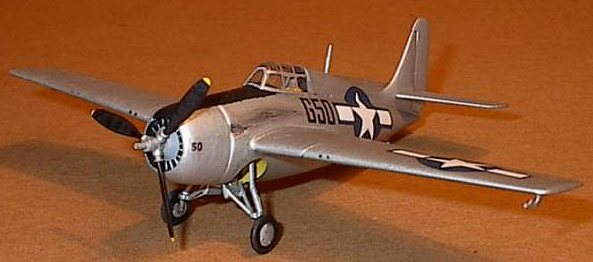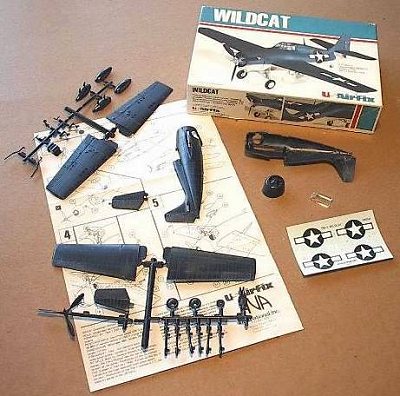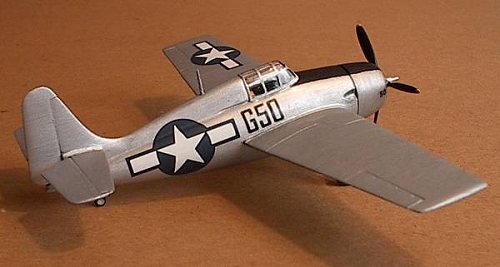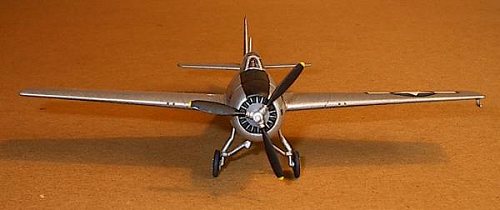
|
KIT: |
US Airfix 1/72 Wildcat |
|
KIT # |
10050 |
|
PRICE: |
$3.75 in 1980 |
|
DECALS: |
One aircraft |
|
REVIEW & |
Guy King |
|
NOTES: |
|

|
HISTORY |
This old Airfix model is of the General Motors FM-2 Wildcat that was the last version of the Wildcat. Grumman originally designed and manufactured the Wildcat, but in 1942 the company turned over production to General Motors because Grumman’s Bethpage factory was needed to manufacture the new Hellcat.
The FM-2 was the General Motors-built F4F-8 version of the Wildcat. This version was a lighter and more powerful than the Grumman F4F-4. In order to save weight, armament was reduced from the six 0.50 inch machine guns in the F4F-4 to only four guns. Using the Wright Cyclone engine instead of the F4F-4’s Pratt & Whitney Twin Wasp also saved weight. The use of the more powerful Wright Cyclone engine resulted in the FM-2 having a taller tail.
The FM-2 was an ideal
aircraft for the smaller escort carriers of the United States and British
Navies. General Motors produced 4,777 FM-2s by August of 1945. Almost four
hundred were supplied to the British as the Wildcat VI.
|
THE KIT |
This Wildcat model is a USAirfix kit issued in 1979. I remember buying it in 1980 thinking at the time that it was inexpensive and “I will build it someday.” That “someday” turned out to be over twenty years later. Judging from the large and prolific rivets, this Wildcat kit is one of the earlier models produced by Airfix. Airfix has not issued this model in years, perhaps not since I bought the USAirfix kit. This model consists of 32 parts molded in dark blue plastic and a clear canopy. Interior detail only consists of a pilot and seat. The totally non-detailed engine is molded into the cowling. Drop tanks and British air-to-ground rockets are provided. The best feature of the USAirfix kit is the nice set of decals produced by Scale Master Inc.
|
CONSTRUCTION |
The Airfix Wildcat is a somewhat crude model. The following modifications are needed to make it into an acceptable model of the FM-2:
 -
Cut off the rudder and make a larger and taller one out of scrap
plastic.
-
Cut off the rudder and make a larger and taller one out of scrap
plastic.
- Add sheet plastic to fuselage to block the view through the wheel wells.
- Add an instrument panel to cockpit.
- Reshape the engine cowling.
- Modify the landing gear so that the aircraft is level.
- Fill the large holes for the flight stand, drop tanks, and rockets (not used in my model).
Other than the modifications listed above, the Airfix FM-2 goes together in an easy fashion typical of older injection–molded airplane kits.
|
PAINT & MARKINGS |
 While
the decals provided in this kit are for a dark blue and white factory-fresh
aircraft, I decided to paint my Wildcat in the colors of a U.S. Navy advanced
trainer of late WWII. This unusual scheme calls for an aluminum paint finish to
the aircraft. The model was hand painted using Testors paints. The trick to
producing an acceptable hand-painted aluminum finish is to have a good brush,
brush a thin coating, and don’t paint over dry paint. I hand painted Futura
floor wax so that the decals would adhere well, then I sprayed Testors dull-coat
over the model.
While
the decals provided in this kit are for a dark blue and white factory-fresh
aircraft, I decided to paint my Wildcat in the colors of a U.S. Navy advanced
trainer of late WWII. This unusual scheme calls for an aluminum paint finish to
the aircraft. The model was hand painted using Testors paints. The trick to
producing an acceptable hand-painted aluminum finish is to have a good brush,
brush a thin coating, and don’t paint over dry paint. I hand painted Futura
floor wax so that the decals would adhere well, then I sprayed Testors dull-coat
over the model.
The Scale Master insignia provided in the kit were used on my FM-2. The black fuselage codes were printed with an inkjet printer using clear decal paper purchased from Bel Inc. (http://store.yahoo.com/beldecal/cusser.html).
|
CONCLUSIONS |
I really enjoyed making this old Airfix kit. The resulting model airplane is an acceptable rendition of the FM-2 in 1/72. Model kits of the FM-2 are not common compared to the Grumman F4F-4. MPM has produced a 1/72 FM-2 kit that is most likely superior to this old Airfix kit. If you desire a highly-detailed model of the FM-2, a conversion of the 1/72 Hasegawa F4F-4 kit is described in the April 1997 issue of FineScale Modeler.
|
REFERENCES |
Green, William. 1961. “War Planes of the Second World War: Fighters.” Volume Four. Doubleday & Company: New York.
Doll, Thomas, Berkley Jackson, and William Riley. 1983. “Navy Air Colors: United States Navy, Marine Corps, and Coast Guard Aircraft Camouflage and Markings Vol. 1 1911-1945.” Squadron/Signal: Texas.
December, 2001
If you would like your product reviewed fairly and quickly by a site that has thousands of visits a day, please contact me or see other details in the Note to Contributors.